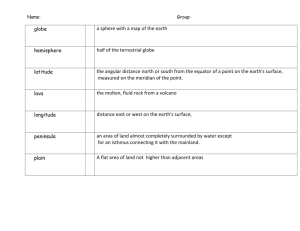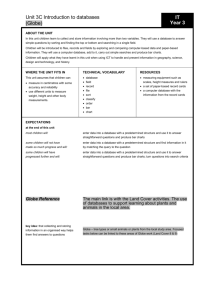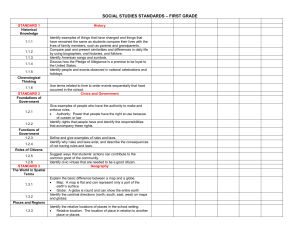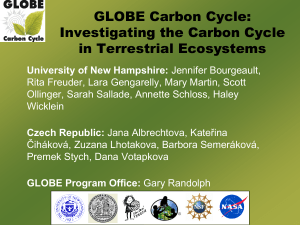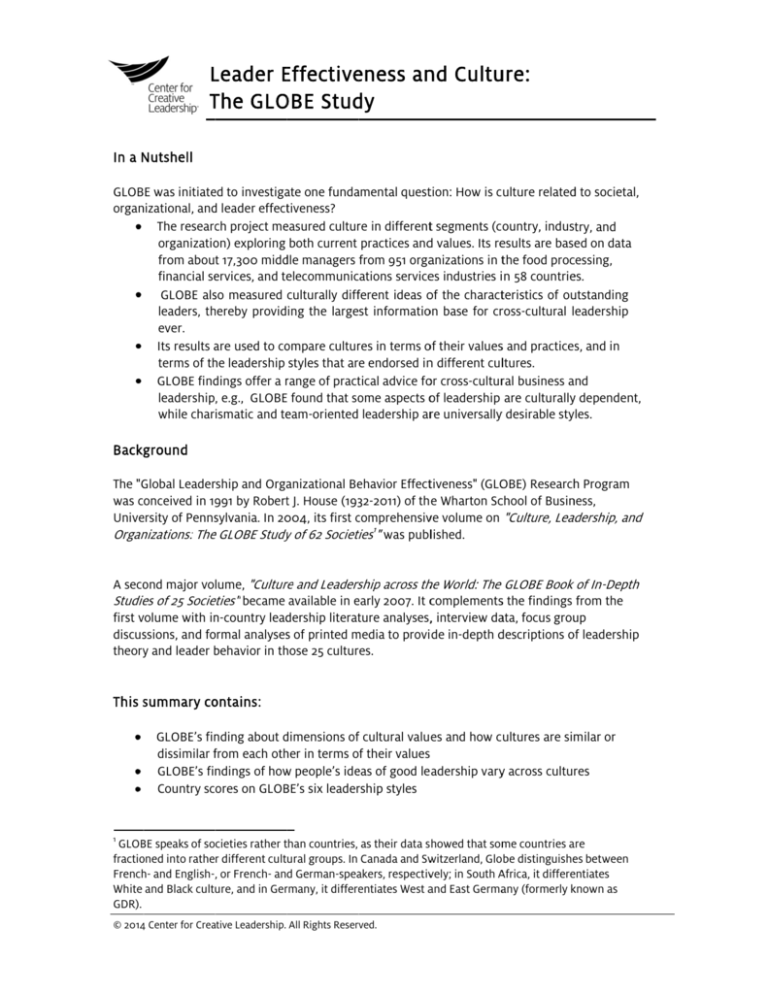
Leader
L
Effective
E
eness annd Cultu
ure:
The
T GLO
OBE Stud
dy
N
In a Nutshell
GLOBE was initiateed to investigaate one fundaamental questtion: How is culture related
d to societal,
nizational, and
d leader effecttiveness?
organ
The researcch project meeasured culturre in differentt segments (country, industry, and
organizatio
on) exploring both current practices andd values. Its reesults are based on data
from about 17,300 midd
dle managers from 951 orgaanizations in tthe food proccessing,
financial seervices, and teelecommunications servicees industries in 58 countriees.
GLOBE alsso measured culturally diffferent ideas oof the charactteristics of ou
utstanding
leaders, th
hereby providing the largest informatioon base for crross-cultural leadership
ever.
Its results are
a used to co
ompare culturres in terms oof their valuess and practices, and in
terms of th
he leadership styles that are endorsed inn different culltures.
GLOBE find
dings offer a range
r
of practtical advice foor cross-culturral business aand
leadership, e.g., GLOBE found that so
ome aspects oof leadership are culturallyy dependent,
while charismatic and teeam-oriented leadership arre universallyy desirable styyles.
Backg
ground
The "G
Global Leaderrship and Orgaanizational Beehavior Effecttiveness" (GLO
OBE) Research
h Program
was conceived in 19
991 by Robertt J. House (19332-2011) of th e Wharton Scchool of Busin
ness,
Univeersity of Pennssylvania. In 20
004, its first comprehensiv
c
ve volume on "Culture, Lead
adership, and
Organ
nizations: Thee GLOBE Studyy of 62 Societi
ties1" was publlished.
A seco
ond major volume, "Culture
re and Leaders
rship across thhe World: The GLOBE Book of In-Depth
Studiees of 25 Socieeties" became available in early
e
2007. It ccomplementss the findings from the
first volume
v
with in
n-country lead
dership literatture analyses,, interview daata, focus grou
up
discusssions, and fo
ormal analysess of printed media
m
to provi de in-depth ddescriptions oof leadership
theoryy and leader behavior
b
in th
hose 25 cultures.
This summary
s
co
ontains:
milar or
GLOBE’s fin
nding about dimensions
d
off cultural values and how cultures are sim
dissimilar from
f
each oth
her in terms of their values
GLOBE’s fin
ndings of how
w people’s ideeas of good le adership varyy across cultures
Country scores on GLOB
BE’s six leaderrship styles
1
GLOB
BE speaks of societies rather than
t
countries, as their data showed that som
me countries aare
fractio
oned into rather different cultural groups. In Canada and Sw
witzerland, Globe distinguishees between
French
h- and English-, or French- and German-speaakers, respectivvely; in South A
Africa, it differeentiates
White and Black culture, and in Gerrmany, it differeentiates West aand East Germaany (formerly kknown as
GDR).
4 Center for Creaative Leadership. All Rights Reserved.
© 2014
Leader Effectiveness and Culture: The GLOBE Study
Cultural Dimensions and Culture Clusters
GLOBE's first major achievement is a comprehensive description of how cultures are different or
similar from one another. GLOBE established nine cultural dimensions that make it possible to
capture the similarities and/or differences in norms, values, beliefs—and practices—among
societies. They build on findings by Hofstede (1980), Schwartz (1994), Smith (1995), Inglehart
(1997), and others. They are:
Power Distance
The degree to which members of a collective expect
power to be distributed equally.
Uncertainty Avoidance
The extent to which a society, organization, or group
relies on social norms, rules, and procedures to alleviate
unpredictability of future events.
The degree to which a collective encourages and rewards
individuals for being fair, altruistic, generous, caring, and
kind to others.
The degree to which organizational and societal
institutional practices encourage and reward collective
distribution of resources and collective action.
The degree to which individuals express pride, loyalty, and
cohesiveness in their organizations or families.
The degree to which individuals are assertive,
confrontational, and aggressive in their relationships with
others.
The degree to which a collective minimizes gender
inequality.
The extent to which individuals engage in future-oriented
behaviors such as delaying gratification, planning, and
investing in the future.
The degree to which a collective encourages and rewards
group members for performance improvement and
excellence.
Humane Orientation
Collectivism I
(Institutional)
Collectivism II (In-Group)
Assertiveness
Gender Egalitarianism
Future Orientation
Performance Orientation
This allowed GLOBE (see Figure 1) to place 60 of the 62 societies into culture clusters, similar to
those by other previous studies (Ronen and Shenkar, 1985; Inglehart, 1997; Schwartz, 1999).
Cultural similarity is greatest among societies that constitute a cluster; cultural difference
increases the farther clusters are apart. For example, the Nordic cluster is most dissimilar from
the Eastern European cluster.
© 2014 Center for Creative Leadership. All Rights Reserved.
Leadeer Effectiveneess and Cultu
ure: The GLO
OBE Study
Adaptted from House et al. (2004
4).
Cultu
ural Ideas off Outstandin
ng Leaders
GLOBE’s other major finding is how
h different cultures concceptualize outstanding lead
ders. GLOBE
is based on the preemise that leaader effectiven
ness is contexxtual, that is, iit is embeddeed in the
ms, values, and beliefs of thhe people beinng led. In other words, for
societtal and organiizational norm
a lead
der to be effecctive, the timee-tested adage applies: "Whhen in Rome, do as the Romans do."
Leadeership Categorrization Theorry (Lord & Maaher, 1991) staates that everyyone has an implicit idea
of what leaders loo
ok, act, and beehave like. These ideas are rooted in peoople’s early exxperiences
pectations
with leaders and arre shaped by one’s culture and upbringing. They thenn become exp
4 Center for Creaative Leadership. All Rights Reserved.
© 2014
Leader Effectiveness and Culture: The GLOBE Study
about what good leadership is, and these expectations serve as a personal benchmark for
people to determine if a leader is effective, good, and worth following — or not. GLOBE was the
first study to investigate the contents of people’s expectations of leaders on such a broad scale,
and also link them with cultural values and practices.
GLOBE examined 112 leader characteristics, such as; modest, decisive, autonomous and
trustworthy, based on the following definition of leadership: an outstanding leader is a person in
an organization or industry who is "exceptionally skilled at motivating, influencing, or enabling
you, others, or groups to contribute to the success of the organization or task." The first round of
analysis generated 21 leadership scales, which in turn folded into six superordinate leader styles.
Based on a 7-point scale and the "world mean" of each scale (i.e., the average of 61 country
means), the 21 leadership scales ranked from the "most universally desirable" to "the least
universally desirable" as follows:
Integrity (6.07)
Inspirational (6.07)
Visionary (6.02)
Performance-oriented (6.02)
Team-integrator (5.88)
Decisive (5.80)
Administratively competent (5.76)
Diplomatic (5.49)
Collaborative team orientation (5.46)
Self-sacrificial (5.0)
Modesty (4.98)
Humane (4.78)
Status conscious (4.34)
Conflict inducer (3.97)
Procedural (3.87)
Autonomous (3.85)
Face saver (2.92)
Non-participative (2.66)
Autocratic (2.65)
Self-centered (2.17)
Malevolent (1.80).
These 21 leadership scales were statistically and conceptually reduced to six styles. The first two
styles, charismatic/value based and team-oriented style, were seen as contributing to
outstanding leadership in all cultures. However, for the other four styles, cultural variation was
larger: In some cultures, they were seen as good and effective styles, while other cultures saw
them as hindering outstanding leadership. Below, the six styles are listed in the order of least
cultural variation to most cultural variation. We also indicate the range of ratings each style
received in the different countries.
1. The charismatic/value based style (4.5 – 6.5) stresses high standards, decisiveness, and
innovation; seeks to inspire people around a vision; creates a passion among them to
perform; and does so by firmly holding on to core values. This includes the facets of
visionary, inspirational, self-sacrificial, integrity, decisive, and performance-oriented.
2. The team-oriented style (4.7 – 6.2) instills pride, loyalty, and collaboration among
organizational members; and highly values team cohesiveness and a common purpose
or goals. This style includes the facets of collaborative team orientation, team
integrator, diplomatic, (reverse scored) malevolent, and administratively competent.
3. The participative style (4.5 – 6.1) encourages input from others in decision making and
implementation; and emphasizes delegation and equality. This style includes the facets
of (reverse scored) autocratic and (reverse scored) non-participative.
© 2014 Center for Creative Leadership. All Rights Reserved.
Leader Effectiveness and Culture: The GLOBE Study
4. The humane style (3.8 – 5.6) stresses compassion and generosity; and it is patient,
supportive, and concerned with the well-being of others. This style includes the facets of
modesty and humane-oriented.
5. The self-protective (2.5 – 4.6) style emphasizes procedural, status-conscious, and 'facesaving' behaviors; and focuses on the safety and security of the individual and the
group. This style includes the facets of self-centered, status-conscious, conflict inducer,
face saver, and procedural.
6. The autonomous style (2.3 – 4.7) includes only one facet concerned with autonomy. It is
characterized by an independent, individualistic, and self-centric approach to leadership.
Table 1 below gives scores for the six leader styles. Note that scores between 1 and 3.5 indicate
that a style is seen as inhibiting outstanding leadership, while scores from 4.5 to 7 indicate that
a style is seen as contributing to outstanding leadership. Scores between 3.5 and 4.5 indicate
that a style doesn’t much matter for outstanding leadership.
Country
Albania
Argentina
Australia
Austria
Bolivia
Brazil
Canada
(Englishspeaking)
China
Colombia
Costa Rica
Denmark
Ecuador
Egypt
El Salvador
England
Finland
Georgia
Germany
(West)
Charismatic
TeamOriented
SelfProtective
Participative
5.70
5.98
6.09
6.03
6.01
6.01
6.16
5.87
5.99
5.81
5.74
6.10
6.17
5.84
4.55
3.46
3.05
3.07
3.83
3.50
2.96
4.51
5.89
5.71
6.00
5.30
6.06
6.09
5.15
4.70
5.09
4.93
4.56
4.84
5.20
3.81
4.55
3.95
4.47
3.92
2.27
3.65
5.57
6.04
5.95
6.01
6.46
5.57
6.08
6.01
5.94
5.65
5.84
5.57
6.07
5.81
5.70
6.21
5.55
5.95
5.71
5.86
5.86
5.49
3.80
3.37
3.55
2.82
3.63
4.21
3.44
3.04
2.55
3.90
2.97
5.05
5.51
5.54
5.80
5.51
4.69
5.40
5.57
5.91
4.89
5.88
5.18
5.05
4.99
4.23
5.13
5.14
4.69
4.90
4.30
5.61
4.44
4.07
3.34
3.46
3.79
3.53
4.49
3.47
3.92
4.08
4.57
4.30
© 2014 Center for Creative Leadership. All Rights Reserved.
Humane- Autonomous
Oriented
Leader Effectiveness and Culture: The GLOBE Study
Country
Germany
(East)
Greece
Guatemala
Hong Kong
Hungary
India
Indonesia
Ireland
Israel
Italy
Japan
Kazakhstan
Kuwait
Malaysia
Mexico
Morocco
Namibia
Netherlands
New
Zealand
Nigeria
Philippines
Poland
Portugal
Qatar
Russia
Singapore
Slovenia
South Africa
(Black
sample)
South Africa
(White
sample)
South Korea
TeamOriented
SelfProtective
Participative
5.87
5.51
3.33
5.70
4.60
4.35
6.02
6.00
5.67
5.91
5.85
6.15
6.08
6.23
5.99
5.49
5.54
5.90
5.89
5.66
4.81
5.99
5.98
5.87
6.12
5.94
5.58
5.91
5.72
5.92
5.82
5.91
5.87
5.56
5.73
5.90
5.80
5.75
5.15
5.81
5.75
5.44
3.49
3.77
3.68
3.24
3.78
4.13
3.01
3.64
3.26
3.61
3.36
4.02
3.50
3.86
3.26
3.36
2.87
3.19
5.81
5.45
4.87
5.23
4.99
4.61
5.64
4.96
5.47
5.08
5.10
5.03
5.12
4.64
5.32
5.48
5.75
5.50
5.16
5.00
4.89
4.73
5.26
5.43
5.06
4.68
4.37
4.68
4.26
5.21
5.24
4.71
4.10
5.10
4.81
4.78
3.98
3.38
4.38
3.23
3.85
4.19
3.95
4.26
3.62
3.67
4.58
3.39
4.03
3.86
3.34
3.77
3.53
3.77
5.77
6.33
5.67
5.75
4.51
5.66
5.95
5.69
5.16
5.65
6.06
5.98
5.92
4.75
5.63
5.77
5.91
5.23
3.90
3.33
3.53
3.11
3.92
3.69
3.32
3.61
3.63
5.19
5.40
5.05
5.48
4.76
4.67
5.30
5.42
5.05
5.48
5.53
4.56
4.62
4.66
4.08
5.24
4.44
4.79
3.62
3.75
4.34
3.19
3.38
4.63
3.87
4.28
3.94
5.99
5.80
3.20
5.62
5.33
3.74
5.53
5.53
3.68
4.93
4.87
4.21
Charismatic
© 2014 Center for Creative Leadership. All Rights Reserved.
Humane-
Autonomous
Oriented
Leader Effectiveness and Culture: The GLOBE Study
Country
Spain
Sweden
Switzerland
(German)
Taiwan
Thailand
Turkey
USA
Venezuela
Zambia
Zimbabwe
Charismatic
TeamOriented
SelfProtective
Participative
HumaneOriented
Autonomous
5.90
5.84
5.93
5.93
5.75
5.61
3.39
2.82
2.93
5.11
5.54
5.94
4.66
4.73
4.76
3.54
3.97
4.13
5.58
5.78
5.96
6.12
5.72
5.92
6.11
5.69
5.76
6.01
5.80
5.62
5.86
5.97
4.28
3.91
3.58
3.16
3.82
3.67
3.21
4.73
5.30
5.09
5.93
4.89
5.29
5.58
5.35
5.09
4.90
5.21
4.85
5.26
5.18
4.01
4.28
3.83
3.75
3.39
3.43
3.37
Unfortunately, data for the Czech Republic, France, Iran, and Switzerland (French) were not available for compiling
this table.
Source: Adapted from Den Hartog et al., 1999
The differences in cultural acceptance of the different leader styles also manifest in concrete
behaviors. A more detailed analysis identified that leader characteristics such as ambitious,
enthusiastic, formal, logical, or risk taker are valued very differently around the world. For
example, on GLOBE's 7-point scale to measure a society's view of these leader traits, the culture
means for “risk taker” range from 2 to 6. This is in line with the extent to which countries
tolerate uncertainty, as measured by GLOBE's uncertainty avoidance dimension, as described
above, and it shows how cultural values and people’s ideas of good leadership are one
integrated system. On the other hand, there are also some leader characteristics that are
universally endorsed across all the societies in the GLOBE study: People want their leaders to be
trustworthy, just, honest, decisive, and so forth. However, how these traits are expressed and
enacted may still be noticeably different from society to society. For example, for a leader to be
described as decisive in the U.S., he or she is expected to make quick and approximate
decisions. In contrast, in France or Germany, being decisive tends to mean a more deliberate
and precise approach to decision making. The same caution applies to the universally
undesirable leader traits.
© 2014 Center for Creative Leadership. All Rights Reserved.
Leader Effectiveness and Culture: The GLOBE Study
GLOBE's Significance
Harry Triandis, a key thought leader in cross-cultural research, calls the GLOBE research "the
Manhattan Project of the study of the relationship of culture to conceptions of leadership"
(2004). There are a number of reasons for this assessment.
GLOBE is the most comprehensive study to date that empirically researched the relationship
between culture and leader behavior in so many societies, with so many different quantitative
and qualitative measures and methods, and in so many different organizations. It did so by
engaging more than 170 collaborators from around the world who brought to the project an indepth understanding of their own culture and its notion and practice of leadership.
Perhaps most importantly, and in the words of its principal investigator, Robert J. House, "[M]y
final conclusion is that we are in a position to make a major contribution to the organizational
behavior and leadership literature. To date more than 90% of the organizational behavior
literature reflects U.S.-based research and theory. Hopefully GLOBE will be able to liberate
organizational behavior from the U.S. hegemony" (2004).
~ Michael H. Hoppe & Regina Eckert
Bibliography and References about GLOBE:
Alas, R. (2006). Ethics in countries with different cultural dimensions. Journal of Business Ethics, 69(3),
237-247.
Alas, R., & Tuulik, K. (2004). Leadership style as a determinant of creativity Profiles in Estonian
organizations. EBS Review, Summer, No. 18, 66-71.
Alas, R., & Tuulik, K. (2005). Ethical values and commitment in Estonian companies. EBS Review, 19, 7383.
Alas, R., & Tuulik, K. (2007). Cultural practices and values at the societal level in Estonia in comparison
with neighbouring countries. Journal of Business Economics and Management, Vol. VIII, No. 1, 3944.
Alas, R., Edwards, V., & Tuulik, K. (2007). Work-related attitudes and cultural practices and values in
Finno-Ugrian countries. Journal of Cross-Cultural Competence and Management, Vol. 5, 235-254.
Alas, R., Gao, J., & Carneiro, J. (2010.) Connections between ethics and cultural dimensions. Engineering
Economics, 21(3), 255-262.
Alas, R., Gao, J., Lorents, P., Übius, Ü., Matsak, E., & Carneiro, J. 2011. Associations between ethics and
cultural dimensions: Similarities and differences concerning ethics in China, Brazil and Estonia.
Megadigma Journal, 4(2), 153-162.
Alas, R., Kaarelson, T., & Niglas, K. (2008). Human resource management in cultural context. EBS Review,
24, 49-61.
Alas, R., Kraus, A., & Niglas, K. (2009). Manufacturing strategies and choices in cultural contexts. Journal
of Business Economics and Management, 10(4), 279-289.
Alas, R., Papalexandris, N., Niglas, K., & Galanaki, E. 2011. Employee commitment and managerial values in a
cultural context. Transformations in Business and Economics, 10(2), 42-59.
Alas, R., Tafel, K., & Tuulik, K. (2007). Leadership style during transition in society: Case of Estonia.
Journal of Global Strategic Management, Vol. 1, No 1, 56-65.
© 2014 Center for Creative Leadership. All Rights Reserved.
Leader Effectiveness and Culture: The GLOBE Study
Alt, R., Alas, R., Catana, D., Lang, R., Steyrer, J., & Tuulik, K. (2003). Leadership in transformation:
Between local embeddedness and global challenges. EBS Review, Autumn, No. 17, 40-51.
Apospori, E., Papalexandris, N., & Galanaki, E. (2005). Entrepreneurial and professional CEOs:
Differences in motive and responsibility profile. Leadership and Organization Development Journal,
26(2), 141.
Ashkanasy, N. M., Trevor-Roberts, E., & Kennedy, J. C. (2000). Leadership attributes and cultural values in
Australia and New Zealand compared: An initial report based on “GLOBE” data. International
Journal of Organisational Behaviour, 2(3), 37–44.
Bajdo, L.M., & Dickson, M.W. (September 2001). Perceptions of organizational culture and women’s
advancement in organizations: A cross-cultural examination. Sex Roles, Vol. 45(5/6).
Baltes, B. B., & Dickson, M. W. (2001). Using life-span models in Industrial/Organizational Psychology: The
theory of Selective Optimization with Compensation. Applied Developmental Science, 5, 51-62.
Brodbeck, F. C. (2006). Navigationshilfe für internationales Change Management. Erkenntnisse aus dem
GLOBE Projekt [Navigation aids for international change management: Implications from the
GLOBE project]. OrganisationsEntwicklung [Organisational Development], 3 (06), 16-31.
Brodbeck, F. C., Frese, M., & Javidan, M. (2002). Leadership made in Germany: Low on compassion, high
on performance. Academy of Management Executive, 16(1), 16-29.
Brodbeck, F.C., Frese, M., Akerblom, S., Audia, G., Bakacsi, G., Bendova, H., Bodega, D., Bodur, M., Booth,
S., Brenk, K., Castel, P., Den Hartog, D., Donnelly-Cox, G., Gratchev, M. V., Holmberg, I., Jarmuz, S.,
Jesuino, J. C., Jorbenadse, R., Kabasakal, H., Keating, M., Kipiani, G., Konrad, E., Koopman, P., Kurc,
A., Leeds, C., Lindell, M., Maczynski, J., Martin., G. S., O’Connell, J., Papalexandris, A.,
Papalexandris, N., Prieto, J. M., Rakitski, B., Reber, G., Sabadin, A., Schramm-Nielsen, J., Schultz, M.,
Sigfrids, C., Szabo, E., Theirry, H., Vondrysova, M., Weibler, J., Wilderom, C., Witkowski, S., &
Wunderer, R. (2000). Cultural variation of leadership prototypes across 22 European countries.
Journal of Occupational and Organizational Psychology, 73, 1-29.
Catana Gh. A., & Catana, D. (2010). Prospective leaders view on Romanian societal culture, Analele
Universitatii din Oradea, Fascicula Stiinte Economice, Tom XIX, nr. 1: 639-644, available at:
http://anale.steconomiceuoradea.ro/volume/2010/n1/Volum-2010-anale-nr-1-iulie-2010.pdf
(indexed Re Pec, DOAJ, EBSCO)
Catana, Doina, & Catana, Gh. A. (2009). Core decisional values and deciders demographic variables in
Romanian organizations, China-USA Business Review, vol. 8, issue 8, pp. 1-7, available at:
http://www.airiti.com/CEPS/ec_en/ecjnlarticleView.aspx?jnlcattype=0&jnlptype=0&jnltype=0&jnlii
d=3423&issueiid=87393&atliid=1763988
Catana, Gh. A., & Catana, D. (2010). Prospective Romanian leaders view on leadership dimensions,
Analele Universitatii din Oradea, Fascicula Stiinte Economice, Tom XIX, nr. 1: 645-650, available at:
http://anale.steconomiceuoradea.ro/volume/2010/n1/Volum-2010-anale-nr-1-iulie-2010.pdf
(indexed Re Pec, DOAJ, EBSCO)
Catana, Gh. A., & Catana, D. (2010). Organisational culture dimensions in Romanian finance industry. Journal
for East-European Management Studies, Vol. 15 (2): 128-148 (ISSN 0949-6181; ISI Thomson-Reuters),
available at: http://findarticles.com/p/articles/mi_qa5451/is_201004/ai_n53932914
Chhokar, J.S. et al (Eds.). 2007 Culture and Leadership across the World: The GLOBE Book of In-Depth
Studies of 25 Societies. Mahwah, NJ: Lawrence Erlbaum.
De Hoogh, A.H.B., & Den Hartog, D.N. (2008). Ethical and despotic leadership, relationships with leader’s
social responsibility, top management team effectiveness and subordinates’ optimism: A multimethod study. The Leadership Quarterly, 19, 297-311.
De Hoogh, A.H.B., Den Hartog, D.N., Koopman, P.L., Thierry, H., Van den Berg, P.T., Van der Weide, J.G., &
Wilderom, C.P.M. (2005). Leader motives, charismatic leadership and subordinates’ work attitude in
the profit and voluntary sector. The Leadership Quarterly, 16, 17-38.
© 2014 Center for Creative Leadership. All Rights Reserved.
Leader Effectiveness and Culture: The GLOBE Study
De Hoogh, A.H.B., Den Hartog, D.N., Koopman, P.L., Thierry, H., Van den Berg, P.T., Van der Weide, J.G., &
Wilderom, C.P.M. (2004). Charismatic leadership, environmental dynamism, and performance.
European Journal of Work and Organizational Psychology, 13, 447-471.
Den Hartog, D. N., House, R. J., Hanges, P. J., Ruiz-Quintanilla, S. A., Dorfman, P. W., & GLOBE co-authors.
(1999). Culture specific and cross-culturally generalizable implicit leadership theories: Are
attributes of charismatic/transformational leadership universally endorsed? The Leadership
Quarterly, 10(2), 219-256.
Dickson, M. W., Den Hartog, D. N., & Mitchelson, J. K. (2003). Research on leadership in a cross-cultural
context: Making progress, and raising new questions. The Leadership Quarterly, 14, 729-768.
[NOTE: Invited Yearly Review article]
Dickson, M. W., Resick, C. J., & Hanges, P. J. (2006). Universality and variation in organizationally-shared
cognitive prototypes of effective leadership. The Leadership Quarterly, 17, 486-505.
Dickson, M. W., Resick, C. J., & Hanges, P. J. (2006). When organizational climate is unambiguous, it is also
strong. Journal of Applied Psychology, 91, 351-364.
Fu, P. P., Kennedy, J. C., Tata, J., Yukl, G. A., Bond, M. H., Peng, T.-K., et al. (2004). The impact of societal
cultural values and individual social beliefs on the perceived effectiveness of managerial influence
strategies: A meso approach. Journal of International Business Studies, 35(4), 284–305.
Hanges, P.J., & Dickson, M. W. (2006). Agitation over aggregation: Clarifying the development of and the
nature of the GLOBE scales. The Leadership Quarterly, 17, 522-536.
Hanges, P.J., Lord, R.G., & Dickson, M. W. (2000). An information processing perspective on leadership and
culture: A case for connectionist architecture. Applied Psychology: An International Review, 49, 133161.
Hofstede, G.H. (1980/2001). Culture's consequences: International differences in work-related values.
Thousand Oaks, CA: Sage.
House R.J. et al. (Eds). (2004), Culture, leadership, and organizations: The GLOBE study of 62 societies.
Thousand Oaks, CA: Sage.
House, R. J., Javidan M., &, Dorfman, P. (2001). The GLOBE Project. Applied Psychology: An International
Review. Vol., 50(4), 489-505.
House, R.J., Javidan M., Dorfman P., &, M. Sully de Luque (2006). A failure of scholarship: Response to
George Graen’s critique of GLOBE. Academy of Management Perspectives.
Inglehart, R. (1997), Modernization and post-modernization: Cultural, economic, and political change in
43 societies. Princeton, NJ: Princeton University Press.
Javidan, M. (2007). Forward-thinking cultures. Harvard Business Review, July-August. Forethought
Globalization. P. 20.
Javidan, M. (2009), January. “Can Jianguo make the transition?” Case commentary, “From Regional Star to
Global Leader.” By Nitin Nohria. Harvard Business Review, p. 38.
Javidan, M., & Dastmalchian, A (2003). Culture and leadership in Iran: The land of individual achievers,
strong family ties, and powerful elite. Academy of Management Executive, 17(4), 127-142.
Javidan, M., & Dastmalchian, A (2009). Managerial implications of the GLOBE Project: A study of 62
societies. Asia Pacific Journal of Human Resources, 47(1), 41-58.
Javidan, M., & House, R.J. (2001). Cultural acumen for the global manager: Lessons from Project GLOBE.
30th Anniversary Special Issue of Organizational Dynamics, 29(4), 289-305.
Javidan, M., & Lynton, N. (2005). The changing face of Chinese executive. Harvard Business Review,
December. Forethought Globalization, economist.com, selected this article as a noteworthy article
from business journals in December 2005.
Javidan, M. Teagarden, M., & Bowen, D. (2010, April). Making it overseas. Harvard Business Review, pp.
109-115.
© 2014 Center for Creative Leadership. All Rights Reserved.
Leader Effectiveness and Culture: The GLOBE Study
Javidan, M., Dorfman, P., Sully de Luque, M., & House, R.J. (2006). In the eye of beholder: Cross cultural
lessons in leadership from Project GLOBE. Academy of Management Perspectives. , 20(1), 67-91.
This paper won the 2007 Best Paper Award.
Javidan, M., Stahl , G. K., Brodbeck , F., & Wilderom , C. P. M. (2005). Cross border transfer of knowledge:
Cultural lessons from Project GLOBE. Academy of Management Executive. , 19(2), 59-76.
Javidan, M., House R.J., Dorfman P., P. Hanges P., & Sully deLuque M. (2006). Conceptualizing and
measuring cultures and their consequences: A comparative review of GLOBE’s and Hofstede’s
approaches. Journal of International Business Studies.
Javidan, M., Stahl, G., Brodbeck, F. C., & Wilderom, C. (2005). Transferring knowledge across cultures:
Lessons learned from project GLOBE. Academy of Management Executive, 19(2), 59-76.
Keating, M., Martin, G. S., Resick, C. J., & Dickson, M. W. (2007). A comparative study of the endorsement of
ethical leadership in Ireland and the United States. Irish Journal of Management, 28, 5-30.
Kennedy, J. C. (2000). Leadership in New Zealand: Findings of the GLOBE study. International Journal of
Organisational Behaviour, 2(4), 45–52.
Kennedy, J. C. (2002). Leadership in Malaysia: Traditional values, international outlook. Academy of
Management Executive, 16(3), 15–26.
Kennedy, J. C., & Mansor, N. (2000). Malaysian culture and the leadership of organizations: A GLOBE
study. Malaysian Management Review, 35(2), 42–53.
Lang, R., Alas, R., Alt, R., Catana, D., & Hartzh, R. (2006). Leadership in transformation – Between local
embeddedness and global challenges. Journal of Cross-Cultural Competence and Management, Vol.
4, 215-246.
Lang, R., Alas, R., Alt, R., Catana, D., & Hartz, R. (2005). Leadership in Transformation: Between Local
Embeddedness and Global Challenges. Journal of Cross-Cultural Competence and Management, 4,
215-246.
Martin, G. S., Resick, C. J., Keating, M., & Dickson, M. W. (2009). Ethical leadership across cultures: A
comparative analysis of German and U.S. perspectives. Business Ethics: A European Review, 18,
127-144.
Mukherjee, K. (2004). An integrative perspective on the stages model of turnaround: the Tribeni Case
Study. IBAT Journal of Management, 1(1), 1-23. (with Dr. Vipin Gupta)
Mukherjee. K. (2004). Leadership styles and followers’ satisfaction and perceived effectiveness. South Asian
Journal of Management, Vol. 11.1.
Nikandrou, I., Apospori, E., & Papalexandris, N. (2003). Cultural and leadership similarities and variations in
the southern part of the European Union. Journal of Leadership and Organizational Studies, 9(3).
Nikandrou, I., Apospori E., Panayotopoulou L., Stavrou , E. T. &, Papalexandris, N. (2008). Training
and firm performance in Europe: the impact of national and organizational characteristics.
International Journal of Human Resource Management, 19(11),2057-2078.
Papalexandris, N. & Panayotopoulou, L. (2004). Exploring the mutual interaction of societal culture and
human resource management practices: Evidence from 19 countries. Employee Relations, 26(5),
495-509.
Papalexandris, N., & Galanaki, E. (2009). Leadership’s impact on employee engagement: Differences
among entrepreneurs and professional CEOs. Leadership and Organizational Development Journal,
30(4), 365-385.
Resick, C. J., Hanges, P. J., Dickson, M. W., & Mitchelson, J. K. (2006). A cross-cultural examination of the
endorsement of ethical leadership. Journal of Business Ethics, 63, 345-359.
Ronen, S., & Shenkar, O., 1985 Clustering countries on attitudinal dimensions: A review and synthesis.
Academy of Management Review, 10(3), 435-454.
© 2014 Center for Creative Leadership. All Rights Reserved.
Leader Effectiveness and Culture: The GLOBE Study
Ruderman, M. N., Eckert, R., & Brodbeck F. C. (2010 March). Using multi-rater assessment of leadership in
cross- cultural settings. PTC (Personnel Testing Council) Quarterly, 4(1), 8–11.
Schwartz, S. H. (1994). Beyond individualism/collectivism: New cultural dimensions of values. In U. Kim et
al. (Eds.), Individualism and collectivism: Theory, methods, and applications. Thousand Oaks, CA:
Sage.
Schwartz, S.H. (1999). A theory of cultural values and some implications for work. Applied Psychology,
48(1), 23-47.
Smith, P.B., & Peterson, M.F. (1995). Beyond value comparisons: Sources used to give meaning to
management work events in twenty-nine countries. Paper presented at the annual meeting of
the Academy of Management, Vancouver, Canada, August 1995.
Steyer, J., Hartz, R, & Schiffinger, M., & (2006). Leadership in transformation: Between local
embeddedness and global challenges. Journal for East European Management Studies, 11(2),
113-139.
Steyrer, J, Schiffinger, Michael; Lang, R. (2007). Ideal und Realbild von Führung. [Ideal and Real Image of
Leadership.] Zeitschrift für Management (ZfM), 2, 4, S. 202-235.
Steyrer, J., Schiffinger, M., & Lang, R. (2008). Organizational commitment: A missing link between
leadership behaviour and organizational performance. Scandinavian Journal of Management,
29(4), 364-374.
Szabo, E., Reber, G., Weibler, J., Brodbeck, F. C., & Wunderer, R. (2001). Values and behavior orientation
in leadership studies: Reflections based on findings in three German-speaking countries.
Leadership Quarterly, 12, 219-244.
Tuulik, K., & Alas, R. (2003). The impact of the values of top managers upon their subordinates values.
Journal of Business Economics and Management, Vol. IV, No 2, 105-114.
Tuulik, K., & Alas, R. (2005). The impact of values and management style upon subordinate commitment,
effectiveness and satisfaction. Management of Organizations: Systematic Research, No. 36, 177-191.
Tuulik, K., & Alas, R. (2008). Estonian transformational leader, Journal of Human Resource
Management. Vol. 1-2, pp. 4-16.
Tuulik, K., & Alas, R. (2009). Leadership style during Estonian transition. Baltic Journal of Management,
4(2), 169-187.
Tuulik, K. and Alas, R. (2010). Leadership in Estonia, Problems and Perspectives in Management, 5(3), 269282.
http://www.regent.edu/acad/global/publications/ijls/new/vol5iss3/tuulik_2.pdf
Tuulik, K., Alas, R. (2010). Leadership in Estonian organizations during transition. International Journal of
Leadership Studies. 5(3), 269-282.
Tuulik, K., Alas, R., Lorents, P., Matsak, E., & Carneiro, J. (2011). Values in institutional context. Problems
and Perspectives in Management, 9(2).
Van Quakebeke, N., Van Knippenberg, D., & Brodbeck, F. C. (2011). Leadership in the eye of the beholder:
The influence of subordinates’ self-perceptions of their evaluations of and responses to leaders.
Leadership Quarterly. Published online: 22.March 2011
Van Quaquebeke, N., & Brodbeck, F. C. (2008). Entwicklung und erste Validierung zweier Instrumente zur
Erfassung von Führungskräfte-Kategorisierung im deutschsprachigen Raum [Development and first
validation of two scales to measure leader categorization in German-speaking countries].
Zeitschrift für Arbeits- und Organisationspsychologie, 52(2), 70-80.
Weibler, J., Brodbeck, F. C., Szabo, E., Reber, G., Wunderer, R., & Moosmann, O. (2000). Führung in
kulturverwandten Regionen: Gemeinsamkeiten und Unterschiede bei Führungsidealen zwischen
Deutschland, Österreich und der Schweiz [Leadership in culturally similar regions: Similarities and
© 2014 Center for Creative Leadership. All Rights Reserved.
Leadeer Effectiveneess and Cultu
ure: The GLO
OBE Study
differences off leadership pro
ototypes in Gerrmany, Austria and Switzerlannd]. Die Betrieb
bswirtschaft,
5, 588-604.
Journaal of World Busi
siness, Special Issue (Spring, 2002), Vol. 37, Issue 1:
Javidan, M. and House, R.J. Leadership an
nd cultures aroound the world:: Findings from
m GLOBE, An
introduction
n to the speciall issue, pp. 1-2.
House, R., Javidan, M., Hanges, P., Dorfm
man, P. Understtanding culturees and implicit leadership
theories acrross the globe: An introductio
on to project GLLOBE, pp. 3-10.
Gupta, V., Surie, G., Javidan, M., Chhokarr, J. Southern Assia cluster: Where the old meets the new?,
pp. 16-27.
Ashkanasy, N. M., Trevor-R
Roberts, E., Earrnshaw, L. The A
Anglo Cluster: Legacy of the B
British
Empire, pp. 28-39.
Kabasakal, H.,
H Bodur, M. Arabic
A
cluster: A bridge betweeen East and W
West, pp. 48-54.
Szabo, E., Brodbeck, F. C., Den Hartog, D.. N., Reber, G., Weibler, J., Wuunderer, R. The Germanic
Europe cluster: Where employees have a voice, pp. 55-668.
Bakacsi, G., Sandor, T., And
dras, K., Viktor,, I. Eastern Euroopean cluster: Tradition and ttransition,
pp. 69-80.
Jesuino, J. C.
C Latin Europe cluster: From South
S
to North,, pp. 81-89.
4 Center for Creaative Leadership. All Rights Reserved.
© 2014

